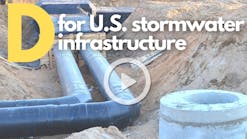The City of Hoboken has a long history of flooding. The densely populated city sits along the Hudson River in New Jersey on one square mile of mostly reclaimed marshland. Two-thirds of Hoboken lies in FEMA’s flood zone and most of the city’s water infrastructure dates back a century or more.
The city’s flooding woes are only exacerbated during rainfall and tidal events. When heavy rain coincides with a high tide in the Hudson River, excess stormwater overtaxes the collection system. When this happens, the combined sewer system backs up into basements and streets, causing localized flooding in the lowest-lying areas.
The North Hudson Sewerage Authority (NHSA) has worked tirelessly to upgrade and modernize Hoboken’s combined sewer collection system since purchasing and taking control of the sewer lines within the city in 1998.
“It’s not as bad as it used to be, but 75% of Hoboken is in the 100-year floodplain and I would say about 20% of it is at or below mean high tide,” says Fred Pocci, authority engineer, NHSA. “When we took over operation of the sewer system, every time it rained the streets flooded. We looked at the elevation and said we have to pump this water out of here.”
Major Relief for Northwest Hoboken
While the H1 pumping station provided southwest Hoboken relief from chronic flooding, the city’s northwest region remained vulnerable—with even a passing steady rain routinely causing flooding that damaged cars, homes, and businesses.
To resolve the ongoing issue, NHSA partnered with the municipality to install a second wet weather pumping station to help the area stay above water during major storms.
“The next thing we tackled was the very low spot in central Hoboken around Madison and Ninth Street,” explains Pocci. “Mid-Hoboken drains through 11th Street so we built it completely underground—controls, pump station, everything—because it’s in the flood zone.”
Smart pumps and controls from Xylem’s Flygt brand contributed to the innovative pump station design that helped Hoboken reduce costs, increase efficiencies, and alleviate stormwater flooding for the city on the Hudson River. The station features two high-performance submersible pumps, each with a capacity of 40 MGD, for a total pumping capacity of 80 MGD. During intense rain events at high tide, the pumps will pump against the tide, preventing the combined sewers from filling to capacity and overflowing into the community.
“The efficient Flygt propeller pump with its submersible motor is ideal for stormwater pumping,” says John Corkery, municipal sales manager, PSI Process, a Xylem representative in Middlesex, NJ.
Flygt propeller pumps are designed to transport large volumes of water at low heads. The slim profile of these pumps provides a considerably smaller pump station footprint than that of non-submersible pumps, reducing capital costs and construction disturbance. Flygt submersible propeller pumps operate directly in the pumped liquid and are easily installed and removed from the pump station. No fastening bolts are required. Because the pumps operate in and are submerged in the pumped liquid, they are easy to install and the motors run cooler and more quietly than those of non-submersible propeller pumps. In addition, the pumps incorporate Flygt N-technology, known for its self-cleaning capabilities, and sustained high efficiency.
Compact Layout
The slim profiles of the Flygt submersible pumps provided another major benefit. With limited space for the wet weather pumping station in the densely populated city, the pumps’ slender design facilitated installation in the extremely tight quarters of the underground facility.
Little of the H5 pumping station is visible above ground, other than a pair of generators and a curved green pipe that stand in a roadway divider down the center of 11th Street, west of Hudson Street.
“H5 is situated in a high-end residential community,” says Phil Reeve, facility operator, NHSA. “Top on their list was they didn’t want to see anything after it was done, so the whole control building for the pump station is below grade and its entrance is in the middle of a center median with plantings all around it. You could drive by it a hundred times and never even see it.”
Tracking Pump Performance
After the H1 pumping station went online, NHSA commissioned a report to see how well the stormwater pumps were doing to prevent flooding in the city’s northwest region.
“We needed a way to assess how effective the pump was at keeping the streets from flooding,” said Don Conger, facility operator, NHSA.
Flow sensors were installed throughout the system, and data was collected and analyzed over a six-month period. During that time frame, the monitoring system identified 36 rain events that triggered the pumps. Previously, these events would have caused significant street flooding. With the pumps operating, only four events saw street water pooling, which was rapidly drained off by the pump station.
“During those six months, we had enough rain on the street where it would have flooded the city out, but we only saw some flooding in four of those events,” says Conger. “The results were very clear that the pump station was doing its job and keeping the water off the streets.”
The NHSA realized similar results with the H5 pump station. Between November 2016 and April 2017, the H5 pump station handled four rain events that would previously have caused flooding along 9th and Madison streets. During each of those storms, the H5 pump station prevented flooding. Only an extreme storm in May 2017 caused street water to accumulate, but the pump station rapidly drained the water from the roadways.
“One of the unique things about the control system is there’s actually surge predictor programming built into the station, so not only do we monitor the flows and operate the pumps, but we look at it on a time base and try to stay ahead of a flood event,” explains Bryce Parkhurst, senior manager, PSI Process.
Today, the H1 and H5 stations work together during intense rain events at high tide to pump stormwater out of the system against the tide, preventing sewers from filling to capacity and overflowing into the community. Along with the wet weather pump stations, the city’s flood resiliency plan includes green and gray infrastructure initiatives. In recent years, Hoboken has implemented solutions ranging from resiliency parks and rain gardens to capture rainwater during storms to porous pavement and new trees to help reduce stormwater runoff.
Asad Choudry
Asad Choudry is business development manager, Flygt G&G, hydroturbines, A-C Custom Pumps, Xylem. He has over 15 years of experience in product and project management, sales, and applications for centrifugal pumping equipment. Choudry holds a Bachelor of Science in mechanical engineering, specializing in aerospace engineering from Hofstra University in New York.









